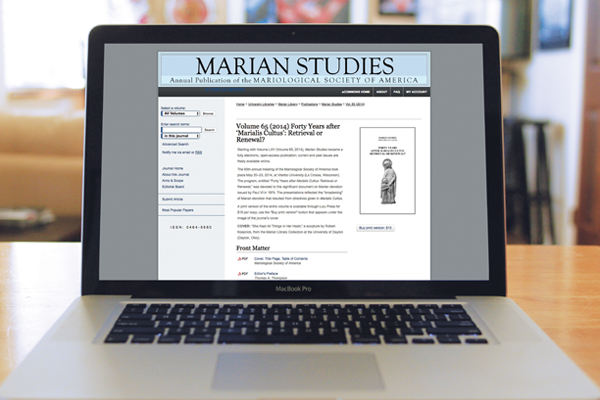Blogs

‘Marian Studies’ presents ‘Marialis Cultus’ from many perspectives
By Maureen Schlangen, E-scholarship and communications manager
Having devoted its entire 2014 meeting to the examination, analysis, inspiration and effects of Pope Paul VI’s 1974 apostolic exhortation Marialis Cultus (Marian Devotion), the Mariological Society of America has recently released nine scholarly articles on the topic in its international journal Marian Studies.
The journal, previously available to subscribers and MSA members only, is now available online free of charge worldwide; a print version also is available. The latest issue — Volume 65 — “reflects the broadening of Marian devotion that resulted from directives given in Marialis Cultus,” said MSA secretary Father Thomas A. Thompson, S.M., editor of the journal since 1990. Some highlights:
- Mary McCaughey, an academic executive with the Priory Institute teaching at the Dominican Studium at St. Saviour’s Priory, Dublin, Ireland, addresses Marian spirituality — distinct from Marian devotion — developing in ecclesial groups such as Focolare, the Emmanuel Community, Youth 2000, and the Marian charismatic movement. McCaughey describes a spirituality focused on the person of Mary as a member of the Church and then leads to a contextual spirituality of communion that promotes living Mary’s receptivity to the Triune God at every stage of the journey of life through faith, hope, and love.
- Patricia A. Sullivan, a professor of theology at St. Anselm College in Manchester, New Hampshire, develops the relation between Marian spirituality and Marian devotion in “Marian ‘Spiritual Attitude’ and Marian Piety,” addressing the “attitudes of devotion” which bind the Church to the Virgin Mary: “profound veneration … burning love … trusting … invocation … loving service … profound wonder … attentive study.”
- Relying on previously unpublished correspondence, Laetitia Rhatigan writes of the letters of Father Patrick Peyton, C.S.C., to participants of Vatican II. During the time of the Council, Peyton wrote to Cardinals Cicognani and Suenens and to Archbishop Edward Louis Heston, C.S.C., urging that the Council encourage family prayer and the Family Rosary. Vatican II did refer to the family as the “domestic Church” in Gaudium et Spes and in the Decree on the Apostolate of the Laity (Apostolicam Actuositatem). After Vatican II, along with many others, Peyton was puzzled by the apparent “victory” of liturgy over devotion, and, in 1969, wrote an impassioned letter to Paul VI, asking the pope to “enhance, enrich and raise to a higher level of efficacy … the Family Rosary, by proclaiming it a liturgical prayer.” Peyton’s letter led to Paul VI’s Marialis Cultus, with its section on the evangelical nature of the rosary and encouragement of the Family Rosary.
- Father Emery de Gaál writes of the contribution of Cardinal Leo Scheffczyk to Mariology after Vatican II. Of his more than 1,200 scholarly articles, about 200 were on Marian topics. Scheffczyk, he says, presents a joyful, positive Christian anthropology based on sound theological exegesis, and in it, Mary has an indispensable role in the drama of salvation: She is the guarantee of the “incarnational principle of the Catholic faith,” to counter a call to an undefined freedom.
- In “Anthropological Aspects of Marian Devotion for the Formation of the 'Feminine Genius',” Danielle Peters points out how an observation in Marialis Cultus was developed in Pope St. John Paul II’s Mulieris Dignitatem. Marialis Cultus indicated that “devotion to the Blessed Virgin must also pay close attention to certain findings of the human sciences” in order to bridge the gap “between some aspects of this devotion and modern anthropological discoveries and the profound changes which have occurred in the psycho-sociological field in which modern man lives and works.”
- Father Thomas A. Thompson, S.M., addresses Pope Paul VI’s principal consultant for composing Marialis Cultus—Ignacio M. Calabuig, O.S.M. Calabuig was rector of the Pontifical Faculty Marianum and a consultant to the Congregation of Divine Worship. Relying on previous writings of both Paul VI and Calabuig, he analyzes sections of Marialis Cultus, suggesting that some sections show the influence of Paul VI and others of Calabuig.
- Father Frederick Miller recounts the deep and lasting impression that St. Louis Grignion de Montfort’s True Devotion to the Virgin Mary had on him more than 30 years ago.
- Monsignor Arthur Calkins addresses Mary’s cooperation in the mystery of Christ as presented in recent ecclesial documents. The word coredemptrix has appeared in papal documents, he writes, but because of ecumenical considerations (“sensitivity”), it did not appear in Vatican II documents. In the commentary of Marialis Cultus on Marian feasts, reference is made to the Blessed Virgin’s “free consent and cooperation in the work of redemption (MC 6), and, in the commentary on the Presentation of Christ (Feb. 2) and the feast of Our Lady of Sorrows (Sept. 15), reference is made to Mary’s “co-suffering with Christ” (MC 7). Marialis Cultus also presents Mary as Virgo offerans: the cooperation of Mother and Son in the work of redemption reaches its climax on Calvary.
- In “Feminist Perspectives on Mary: Retrieval or Renewal?” Gloria Falcão Dodd uses criteria from Marialis Cultus to analyze recent works by three representative feminists — Marina Warner, Sister Elizabeth A. Johnson, and Rosemary Radford Ruether — and three New Feminists — Ronda Chervin, Juli Loesch Wiley, and Michele Marie Schumacher.
The volume closes with the “International Academic Marian Bibliography, 2013–2014,” providing references not only as found in research resources, but also from European Mariological societies and from journals whose articles are not indexed in larger databases.
Cecilia Mushenheim, longtime Marian Library staff member and professor emerita in the University of Dayton Libraries, is the journal’s managing editor and copy editor.
For information about the Mariological Society of America or to submit a paper for presentation at a future meeting, contact Mushenheim (cmushenheim1@udayton.edu).
